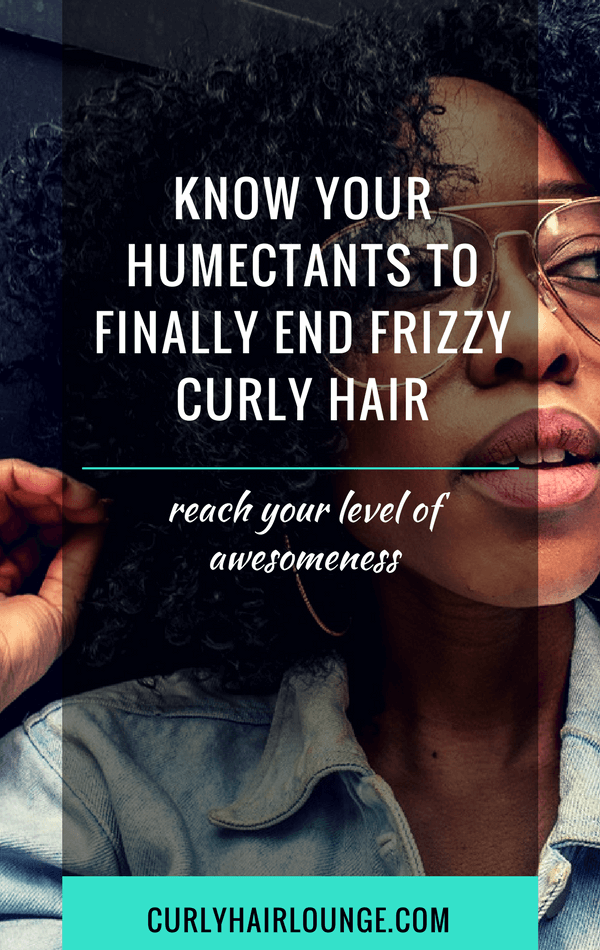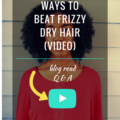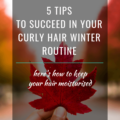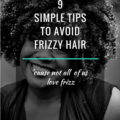There’s no curly girl or any woman for that matter, that doesn’t like to showcase their curls or a perfectly achieved hairstyle. To reach this level of awesomeness and what would certainly be a glorious day-slash-week it’s very important to choose the right products or have the right product combination or one can end up with frizzy curly hair. Any curly girl knows this, right?! To avoid the frizz that always seems to be lurking around it’s critical to have some understanding of humectants.
When it comes to the primary goal of a curly girl, anyone will tell you it is to keep hair moisture. There’s actually no surprise here since the shape of curly hair determines that our hair is naturally dry. The shape of our hair affects the way the lipid protective barrier of the hair protects it and how the cuticle layers of the hair lie which ultimately determines our hair’s ability to retain moisture.
Let me give you a speedy lesson on hair shape and moisture…
Sebum is a waxy substance secreted by the hair’s sebaceous glands, it protects the hair not only against external damage but it prevents the hair from losing moisture quickly. However, because of the shape of curly hair sebum is unable to completely cover its whole length which causes loss of moisture and vulnerability to external damage.
Additionally, the cuticles of the hair which are arranged in a scale-like manner on the surface of the hair can’t perform their function successfully because of all the loops and twists of curly hair. Instead of resting flat to help retain moisture inside, where a loop occurs the cuticles remain ‘open’ and let moisture escape.
Essentially, this means that the shape of curly hair directly influences its ability to stay moisturised. It means it is naturally dry and more prone to damage (brittleness, split ends, hair breakage) than straight hair.
Talk about drama in your life, right?! But this is not all if you factor in hair porosity, the environment (the sun, wind, sea water, low and high temperature, pool water, water quality), heat styling tools, manipulation or chemical treatments the risk of hair damage is even more alarming which makes it even more important to have products capable of moisturising the hair and retaining that moisture in.
This is where humectants come in! They can be the solution to rescue your hair from dehydration. (thought for a minute I was going off-topic with all this talk about moisture?! Relax my friend, it’as all under control. Let’s dive in… 😉 )
Humectants To The Rescue
Humectants are ingredients capable of attracting water from their surroundings and hold on to it keeping the environment they’re in moist or moisturised. Hair care (and beauty) companies will use humectants in a product formulation because of this same ability. Ingredients in this group will absorb water into them and hold it inside the hair keeping it moisturised for a longer period of time.
The great thing about humectants is that they can not only draw water from the products they’re in and when washing the hair, but they can also draw water from the air helping to keep the hair moisturised. However, the same quality that makes them perfect for hair product formulations is also the reason why many curly girls stay away from it.
Confused?! Keep reading…
The naughty side of humectants
Yes, humectants have a naughty or an evil side some would say and that is due to the fact that if the humidity level in the air is too high or low humectants will create havoc in your hair. Simply put, with too much water content in the air humectants will draw too much water into the hair (’cause that’s what they do) making it swell which will raise the cuticle layers and make the hair frizzy, soft and even sticky.
On the other hand, low water content in the air (dry air) makes humectants take moisture away from the hair to the environment which will result in rough, dry hair. In essence, this relationship between temperature and water content in the air refers to the Dew Point, which according to the Collins Dictionary is the temperature at which water vapour in the air becomes saturated and water droplets begin to form.
Controlling Air Humidity
Though it sounds like I’m laying the foundation of a Greek Tragedy, it is possible to know the Dew Point. To save you from all the ‘sciency‘ information let me just say it involves some boring calculations and luckily for you, I’m just gonna drop a link >> here<< where you can find out what is your dew point.
To discover your dew point on the ‘Click to Solve For’ box select dew point and the Temperature Scale you prefer below. Once this is done, on the left move the temperature bar up or down to your local temperature and it will give you your dew point on the right bar (not the middle one).
Don’t know how to translate this information into actual practical information? No worries, keep reading.
To give you some general guidelines for how dry or humid you can expect the air outside to be, use the Dew Point you just calculated and see below where you’re at according to the Weather.Gov.
- Less than or equal to 55(for temperatures in ºF)/13(for temperatures in ºC) – a bit dry
- Between 55 (for ºF)/12 (for ºC) and 65 (for ºF)/18 (for ºC) – dry and comfortable to those on the lower edge but at above 60 (for ºF)/15 (for ºC) humidity is perceived and things are becoming a bit sticky/muggy.
- Greater than or equal to 65 (for ºF)/18 (for ºC) – lots of moisture in the air which starts out by being somewhat uncomfortable but has the temperature continues to rise it will become increasingly uncomfortable and alarming.
Are you still with me?! No panic attack?! Great! Now that we averted two crisis let’s discuss what humectant you can find in your products and how they differ.
Humectants In Your Hair Products
While glycerin is perhaps the best-known humectant alongside panthenol and honey (high five if you already know this! 😉 ) there are many other humectants in the product formulation field. Some are composed of small molecules like glycerin and then there are different compounds that can also act as humectants such as hydrolysed proteins.
Here’s a peek into some of the humectants you can expect to find your product:
- Glycerin
- Propylene Glycol
- Sodium Lactate
- Sodium PCA
- Agave Nectar
- Glucose
- Fructose
- Sorbitol
- Honeyquat
- Capryl Glycol
- Butylene Glycol
- Glycogen
- Hydrolysed Proteins (e.g. Collagen, Keratin, Silk, Elastin)
(For a complete list you can check this article written by polymer and cosmetic scientist Tonya Mackay on Naturally Curly)
In trying to understand how humectants work on the hair it’s important to know that while glycerin is highly demonised and avoided among many curlies for its ability to completely ruin a good hairstyle in high and low humidity conditions in the air, the reality is all humectants have this characteristic.
Interactions and Power
Just as moisturiser X is better at its job than moisturiser Y so are humectants. You can kinda see them in a spectrum where some humectants are really powerful at binding with water and others are mild. Because glycerin is so good (and cheap to buy) at keeping the hair and skin moisturised you will often find it in product formulas.
Examples of some of the more powerful humectants you can find in your products are Glycerin, Propylene Glycol, Sodium PCA, Sodium Lactate.
Now you know this it may be a good idea to avoid these humectants when the humidity levels in the air are low or high, instead go for Sorbitol, Panthenol or Hydrolysed Silk Protein. However, the place where your humectant is placed in the ingredients list may also weaken its effectiveness/power. If it is placed within the first five ingredients it has a bigger impact on the hair than if it’s placed somewhere in the middle or even at the bottom.
Additionally, a milder humectant may be used in conjunction with a stronger one in the formula to create some sort of balance.
Solutions
Well formulated products will have humectants to attract and hold water inside the hair and emollients to lock/seal in the moisture and delay moisture release. Making sure your product has a good balance of vegetable oils and butters will not only do this but it will also create a barrier that will prevent humectants from binding to more available water, therefore, helping you avoiding frizzy curly hair or very dry hair.
Another solution people have readily embraced when it comes to humectant is to avoid all products that have glycerin in the formula in order to avoid all possible outcomes (some are now advertised as being glycerin free). However, avoiding them may not be the best solution as they are very good at keeping curly hair moisturised and well-formulated products will have them.
Instead, you can use a hair journal and record your product use and outcome to discover what works best for you (you can use a notebook or this hair journal I created).
 Lastly, a silicone-based oil would solve the whole issue, but we all know how controversial they are among curlies as well… they would create a light but effective film, but in the impossibility to use them and knowing how to use them (yes, they can be tricky for curly hair, know more here) you can use a broccoli oil which has been known to mimic the effects of silicone. Dope, right?!
Lastly, a silicone-based oil would solve the whole issue, but we all know how controversial they are among curlies as well… they would create a light but effective film, but in the impossibility to use them and knowing how to use them (yes, they can be tricky for curly hair, know more here) you can use a broccoli oil which has been known to mimic the effects of silicone. Dope, right?!
I like to buy my natural ingredients from Sheabutter Cottage and if you’re interested you can buy from them here. (Psst… it’s just to let you know that if you buy from this link I get a really huge commission and become filthy rich. Well, more like £0.45 or so richer. 😀 ).
How have humectants affected your use or purchase of hair products?
Featured Image: Photo by Maria Badasian on Unsplash







12 thoughts on “Know Your Humectants To Finally End Frizzy Curly Hair”
By “humectants” you mean a specific product, like a hair mist or are you referring to all products that can moisturize in one way or another like shampoo, conditioner, butter, etc?
Hello Maria,
No. Humectants are a category of ingredients in hair products and they attract and hold moisture to the surface of the hair strand. You need to look in the product’s ingredients list for the ingredients (e.g. glycerin) I make reference in this post. Generally speaking all or most products have this ingredient category, however, it is in your styling products that it will have more effects. Some people avoid them altogether claiming they cause frizzy hair or that it dries their hair, but the secret to avoiding all this is in knowing what humectants your products have and where they have them. I hope I was clear. 🙂
How da hell is hydrolized protein a humecant????
Hello Meow,
Yes, hydrolysed proteins are big protein molecules that have been broken down into their constituent parts (peptides and amino acids). In hair products, they are used to strengthen the hair to make it feel soft and silky but they are also used as humectants.
In simple terms, proteins are amino acids linked together by peptides and together they form a protein. However, when proteins are broken down (hydrolysed) into smaller pieces that can penetrate the hair (amino acids), a water molecule is created in the peptide bond that is still attached to one side of the broken amino acid. These peptide bonds (with their attached water molecules) interact with their environment attracting and retaining water, thus why hydrolysed proteins can be moisturising. Moreover, hydrolysed proteins seem to have an advantage over regular humectants like glycerin or sorbitol since as protein-based humectants they release water more slowly than regular humectants and keep hair moisturised for longer.
I hope this explains your doubt. 🙂
Thank you for this article. So what temperature/dew point range is optimal for using humectancts?
Hi Rae,
You can use humectants any time you want, in fact, it is desirable and most, if not all hair products will have them. If you want to avoid having frizzy hair due to too much hair moisture intake or moisture drown out of the hair make sure you pay attention to air temperature. Use the link in the article insert your temperature and find the dew point. So if the air is dry – dew point under 50(ºF)/10(ºC) – and if you use a product that is high in humectants (meaning in the first 5 ingredients or had several different humectants) like glycerin, moisture will be pulled out of your hair and into the atmosphere. If, on the other hand, the dew point is greater than or equal to 65(ºF)/18(ºC), humectants in your products will attract moisture from the air into your hair and make it frizzy/puffy, as it is loaded with water.
This doesn’t mean you should avoid humectant altogether, it means that, in these situations, you will need to use another product with ingredients that will seal your hair and prevent/delay the exchange of water that will make your hair frizzy.
I hope this makes things clearer, Rae. 🙂
So what products don’t have the humectant last?
There are many products that don’t have ingredients last as there are many products that have ingredients at the beginning of the ingredients list. Products or product formulations are being developed and/or tweaked all the time that is why it is important for people to learn how to identify ingredients in a product’s ingredient list and what they do. This will help them choose the right product for the hairstyle the aim to achieve. Yes, I know it can be daunting to learn all this but most products use similar ingredients or derivatives of an ingredient you already know which would it easier to learn. For the unknown ingredients, Google is of great help or you can look at this post for other resources.
Thank you so much for this well written blog post on such a complex subject. I live on the Northwestern coast of Spain where dew points are always high. After 1,5 years of doing a relaxed version of the CG method I still struggle with this issue… I avoid glycerin as much as possible, but for me propylene glycol is even worse. It makes my coarse, medullated 2b-3a hair so heavy that the curls almost disappear. For example the Tréluxe Serum and Gel, which are well formulated and popular products, totally stretch out my ringlets. Hugs Laura
Hi Laura, I personally haven’t tried that brand but it might be that the consistency of the products is too heavy for your hair or that you need a different application technique.
Hi. This was a good read. I didn’t know about broccoli seed oil.
I’m curious about the application. On high dew days would you just apply it over your hair to create the film? Or apply when styling (like as your setting a twist out or styling a wash n go)
I would use it as a serum.